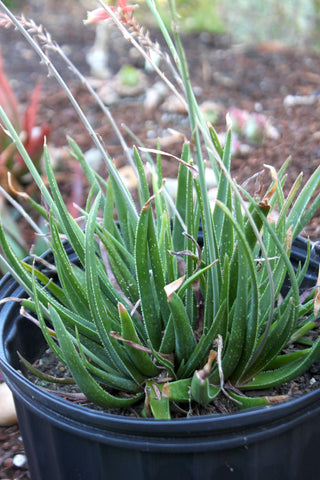Aloes can be categorized into different groups based on any number of characteristics such as their growth habits, leaf structures, species, hybrids, cultivars, medicinal value, geographical distribution and on and on... These categorizations help botanists, horticulturists, and us enthusiasts better understand and classify the diverse range of Aloes found in nature and in cultivation.
For gardeners, it's arguably most helpful to define "aloe types" based on characteristics that are readily observable and relevant to garden cultivation and design. This article focuses on a handful of growth characteristics that influence garden design using an Aloe's: form, size, color, leaf pattern and texture.
Aloe Characteristics
Let's briefly dig into each of these characteristics for a better understanding of how they can help us group Aloes into useful categories. Keep in mind that these characteristics are not entirely stand alone; they sometimes depend on one another for definition which can seem a bit confusing but bear with me as we are discussing aesthetics here, not science!
Plant Form
First up is the concept of a plant's form which can be defined as the overall arrangement of its stems, leaves, and branches. Another way to think of plant form is it's shape or silhouette in the garden. For example does the plant have an arching vase shape, is it low and clumping, solitary or even spreading? Different forms can evoke different aesthetic qualities and serve specific design functions. Classic Aloe forms are:
- Tree Aloes grow to small tree size with branching trunks that form multiple heads and have the general, branched profile of a tree.
- Single-head tree Aloes grow to small tree size with a single trunk, one head and have the general, unbranched profile of a palm tree.
- Clumping Aloes that spread by creating offsets (suckers) come in varying sizes.
- Branching Aloes grow into a shrub form and often can be used as midground or background plants.
- Solitary Aloes have a single rosette and are stemless. These plants do not create offsets or produce just a few offsets at maturity.
- Grass Aloes are named for their thin leaved grassy appearance.
- Climbing Aloes are named for their vine like appearance.
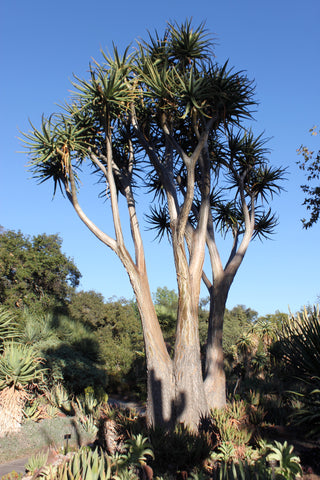
Above: Aloe bainesii demonstrates a branching tree form.

Above: A. ferox x A. Microstrigma demonstrating the single head tree form.

Above: Multiple crowns make up the branching form of Aloe mutabilis

Above: The solitary form of Aloe rubroviolacea.

Above: Clumping form of Aloe mitriformis spreads along a border.
Plant Size
Categorizing Aloes by size can also help gardeners select plants that fit specific spaces and fulfill practical design objectives such as establishing a visual hierarchy.
- Tree-like Size: Aloes with a tree-like size typically have a tall, upright growth habit, resembling small trees or shrubs. These Aloes can serve as focal points or vertical accents in the garden, adding height and architectural interest. Examples include Aloe dichotoma and Aloe bainesii.
- Large Size: Large-sized Aloes are characterized by their substantial stature, with mature plants reaching several feet in height and width. These Aloes make a bold statement in the landscape and are best suited for larger gardens or as standalone specimens. Examples include Aloe ferox and Aloe marlothii.
- Medium Size: Medium-sized Aloes are versatile and adaptable, making them suitable for various garden settings. They typically reach heights between one to three feet and can be used as specimen plants, focal points, or mass-planted to fill larger areas of the garden. A great example is Aloe striata - also known as the Coral Aloe.
- Small Size: Small-sized Aloes are compact and diminutive, making them ideal for small gardens, rockeries, or container plantings. They usually reach heights under one foot and can be tucked into tight spaces, used as border plants, or grouped together for visual impact. Examples include Aloe juvenna and Aloe brevifolia.
- Clumping Size: Aloes with a clumping size form dense clusters of rosettes, either tightly packed together or spaced out. These Aloes are suitable for filling in garden beds, creating lush textures, or providing ground cover. They can also be used to define borders or edges within the landscape. Examples include Aloe humilis and Aloe aristata.

Above: the towering size of Aloe "Hercules"

Above: Aloe Ferox grows to a large size once in the ground.
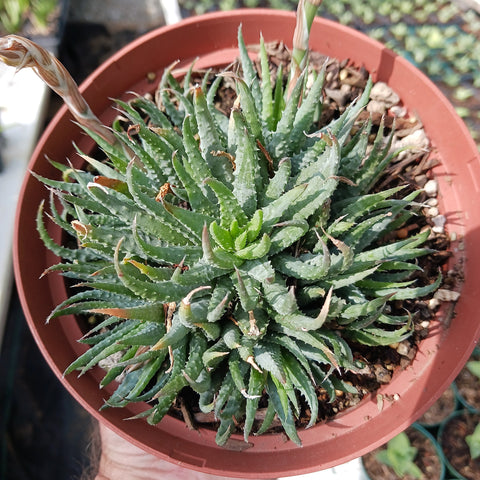
Above: The small, clumping size of Aloe humilis
Color
Categorizing Aloes by overall color is useful in garden design as well. While many Aloes boast traditional green foliage, subtle variations exist, with some displaying lighter hues that inject brightness and freshness, such as Aloe camperi and Aloe rivierei. Others present deep, rich shades of green, like Aloe africana and Aloe marlothii, providing a dramatic backdrop. There are also a smaller set of Aloes that develop a deep red color during times of stress - a great example of this behavior is Aloe cameronii. Flower color is also significant, and worth a separate discussion, ranging from warm tones of orange and red to softer hues of yellow, pink, and white, offering seasonal bursts of vibrancy.

Above: The lighter green color of Aloe "Yemeni Gold"

Above: Cat's Tail Aloe in bloom adds seasonal color (and form) to the garden.
Leaf Pattern
Especially when viewed up close, the patterns found on an Aloe's leaves are an interesting design characteristic. If an aloe leaf doesn't have a solid color it likely falls into one of the three following patterns:
- Variegated Aloes show vertical, slightly wavy, contrasting lines of various shades of color.
- A striated pattern takes the form of thin, uniform lines that run the length of the Aloe's leaves. This pattern is often only visible when viewed closely; from a distance the leaves may look to be a solid color.
- Those with spotted foliage are often a variety of hybridized, low, clustering Aloes. For example Aloe "Piranha" .
- Mosaic Aloes are similar to maculate Aloes but the spots are more frequent, stretched and knit together giving the impression of a mosaic. An example is Aloe harlana.

Above: The striated leaf pattern of Aloe glauca "Namaqualand"
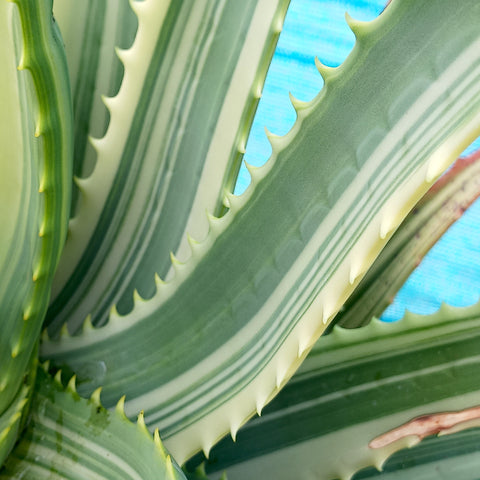
Above: the variegated leaf pattern of Aloe arborescens
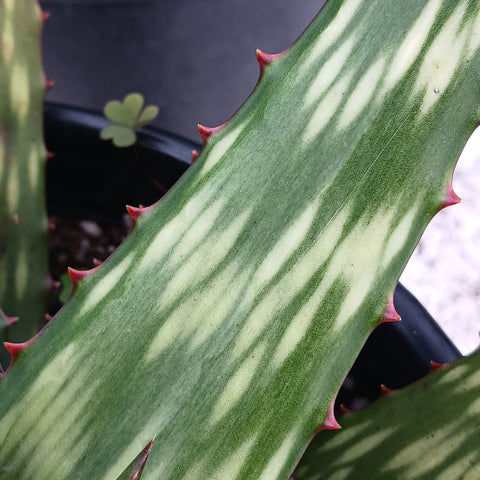
Above: The mosaic leaf pattern of Aloe harlana
Plant Texture
Creating textural contrast and adding tactile interest to the garden is a valuable tool for your design kit as well. Here are several plant texture types commonly used in garden design that also apply to the many varieties of Aloe.
- Fine Texture: Plants with fine-textured foliage have small, delicate leaves or a soft, feathery appearance. Similar to ornamental grasses, there are a few "Grass Aloes" that fill this role such as the aptly named Aloe "Grassy Lassie". Additionally Aloe albiflora and Aloe "Blue Elf" also appear grass-like.
- Coarse Texture: Coarse-textured plants have large, bold leaves or a robust, sturdy appearance. Aloe Examples include Aloe vaombe characterized by its large, broad leaves with prominent teeth along the margins and Aloe excelsa features large, lance-shaped leaves that form a dense rosette.
- Smooth Texture: Some aloes, such as Aloe secundiflora, have a smooth, almost plastic like, texture when viewed closely. This category of plants have glossy or slick foliage that reflects light, creating a sleek and polished appearance.
- Rough Texture: These plants have textured or coarse foliage that adds depth and tactile interest to garden compositions. Examples include the diminutive Aloe humilis as well as the very thorny Aloe aculeata.
- Spikey Texture: Spikey-textured plants have sharp or pointed leaves, adding a bold, architectural element to garden designs. While most Aloes have thorns of varying sizes they do not have true terminal spikes on their leaves like Agave. However, many Aloe have an overall "Spikey" appearance from a distance, such as Aloe suzannae, or a highly thorny appearance when viewed from close up as is the case with Aloe erinacea.
Above: The fine texture of Aloe "Grassy Lassie"

Above: The broad leaves of Aloe vaombe create coarse texture in the garden.
Aloe Groups: Combining Design Characteristics
Combining the characteristics mentioned above allows us to create distinct groups of Aloes that are suited for various garden design applications. Below are several fun and practical groups of Aloes defined by these characteristics.
Towering Architectural Accents:
This group focuses on aloes with particularly tall and striking forms that serve as key architectural elements in the garden. These aloes would likely have a tree-like form, large size, and coarse texture, aiming to create a bold and dramatic impact in the landscape. They could be positioned strategically to draw attention and add structure to the overall design.
Compact Textured Borders
This group comprises aloes with a clumping form and rough texture. These plants, such as Aloe brevifolia and Aloe mitriformis, are designed to define borders or edges within the landscape, adding tactile interest and structure. Their compact size and solid leaf pattern make them suitable for lining garden beds or pathways, where they create a cohesive border that frames the space with their robust presence.
Graceful Grass-like Fillers
This group is distinguished by its grass-like form and fine texture. These aloes, exemplified by Aloe "Grassy Lassie" and Aloe albiflora, are ideal for filling small gardens or containers, where they add softness and delicacy. Their slender leaves create a sense of movement and grace, making them perfect for rockeries, borders, or pots, where they can weave through other plants to create a naturalistic effect.
Midground Color Splash
Encompasses medium-sized Aloes with plain or spotted foliage and coarse texture, exemplified by species like Aloe "Cynthia Giddy" and Aloe maculata. These Aloes contribute to the garden's tactile interest, standing out while harmonizing with neighboring plants. Massing them together intensifies their visual impact, crafting a captivating burst of color and pattern that delineates borders and enhances adjacent foliage.
Leafy Backdrop Aloes
This group showcases aloes characterized by their branching form, large size, and deep green or blue-green coloration, including specimens like Aloe arborescens and Aloe marlothii. Selected for their coarse texture and solid leaf pattern, these aloes serve as a lush and visually appealing backdrop for the garden, adding depth and richness to the landscape. Positioned strategically at the back of garden beds or along fences and walls, they create a natural green backdrop, enhancing the overall aesthetic and providing a verdant canvas against which other plants can shine
Sculptural Solitaries
This group consists of medium to large-sized aloes with a solitary growth habit, characterized by their architectural forms and sculptural presence in the garden. These aloes typically have coarse textures, solid leaf patterns, and may exhibit shades of green, blue-green, or other earthy tones. Positioned as focal points or accents in the landscape, they command attention with their imposing stature and distinctive shapes. These aloes serve as captivating standalone specimens, adding drama and visual interest to any outdoor space. Examples include: Aloe conifera, Aloe vanbalenii, Aloe reitzii, and Aloe lukeana.
What's Next?
In part two of this article we'll explore how to combine some of these Aloe groups in your garden using design concepts like contrast and repetition.

